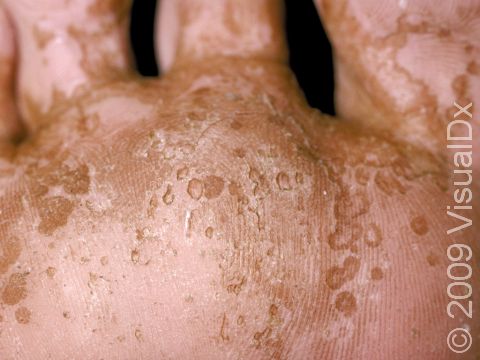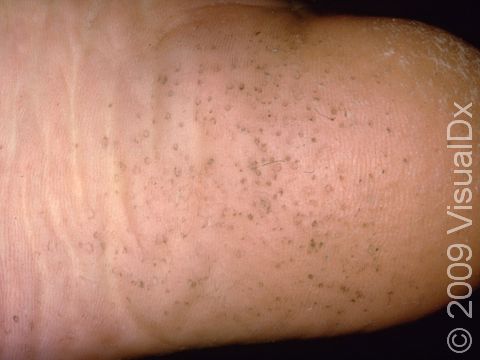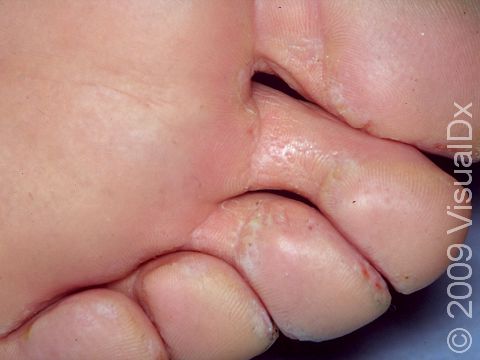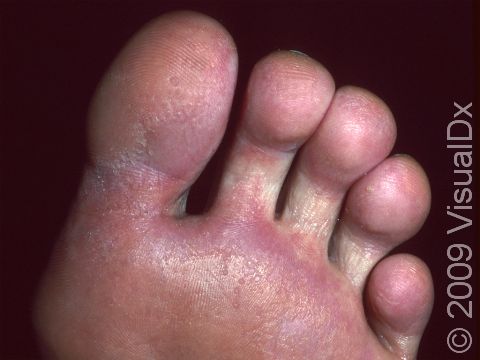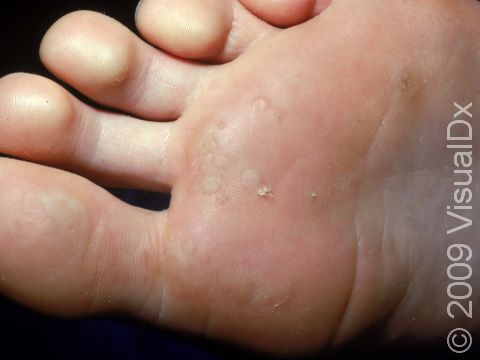Pitted Keratolysis
Pitted keratolysis is a skin condition affecting the soles of the feet and, less commonly, the palms of the hands. It is caused by a bacterial infection of the skin and may give off an unpleasant odor.
Who's At Risk?
Pitted keratolysis can occur in people of any race, any age, and either sex, though it is more common in males. Athletes and military personnel tend to develop this condition most commonly. Conditions that make people more likely to develop pitted keratolysis include:
- Sweaty feet
- Hot or humid weather
- Unventilated (occlusive) footwear, such as rubber boots or vinyl shoes
Signs & Symptoms
The most common locations for pitted keratolysis include:
- Pressure-bearing sites on the soles of the feet, especially the heels
- Non-pressure-bearing sites on the soles of the feet
- Palms of the hands
In these areas, the condition appears as white patches studded with small (0.5–5 mm), shallow pits in the superficial skin. These pits can sometimes join together (coalesce) to form larger, crater-like lesions.
Pitted keratolysis may occasionally be itchy or painful. The foot odor often associated with pitted keratolysis may be socially embarrassing.
Self-Care Guidelines
Keeping the feet as dry as possible is important. Try the following:
- Wear absorbent cotton socks and change them frequently.
- Wear wool socks, which may wick moisture away from the foot.
- Wash your feet with antibacterial soap or antiseptic cleanser daily.
- Consider using a hairdryer to dry feet thoroughly after washing them.
- Apply antiperspirant to the soles of your feet daily.
- Minimize the use of tight-fitting, occlusive footwear. (Try sandals if possible.)
- Avoid wearing the same pair of shoes 2 days in a row.
Treatments
In addition to recommending the above steps to minimize moisture, a physician may try the following:
- Prescription-strength antiperspirant containing aluminum chloride
- Prescription antibiotic lotions such as clindamycin, erythromycin, or mupirocin
- Antifungal cream such as miconazole or clotrimazole
- Prescription oral antibiotics such as erythromycin
- Injections of botulinum toxin (in severe cases)
With some combination of these treatments, the skin lesions and odor of pitted keratolysis usually disappear within 4 weeks.
Visit Urgency
If attempts to minimize moisture do not improve the condition, make an appointment with a dermatologist or another physician.
Trusted Links
References
Bolognia, Jean L., ed. Dermatology, pp.1129. New York: Mosby, 2003.
Freedberg, Irwin M., ed. Fitzpatrick’s Dermatology in General Medicine. 6th ed, pp.1875-1876. New York: McGraw-Hill, 2003.
Last modified on October 10th, 2022 at 4:10 pm

Not sure what to look for?
Try our new Rash and Skin Condition Finder
